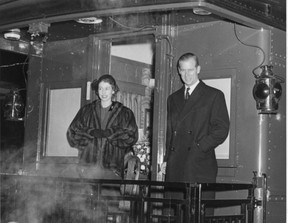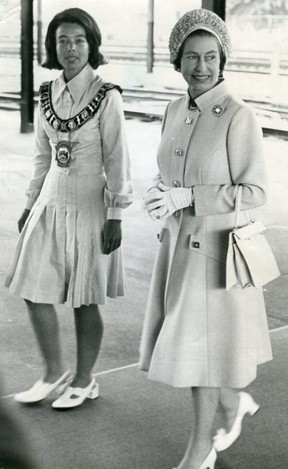London’s royal connections: Five fun facts for Victoria Day
Victoria Day #VictoriaDay

Breadcrumb Trail Links
Not surprisingly for a place named after London, England, the Forest City has strong historical ties to the British Royal Family, who have been visitors in this community since soon after it officially became a city.
Publishing date:
May 23, 2022 • 45 minutes ago • 3 minute read • Join the conversation  Jeff Shaughnessy, a municipal policy specialist at city hall who serves as its “subdivision ambassador,” said the Royal Family is one of the historical themes city hall has drawn from to come up with names for streets, gardens and parks, the best known being Victoria Park. Photograph taken on Friday, May 20, 2022. (Derek Ruttan/The London Free Press) Article content
Jeff Shaughnessy, a municipal policy specialist at city hall who serves as its “subdivision ambassador,” said the Royal Family is one of the historical themes city hall has drawn from to come up with names for streets, gardens and parks, the best known being Victoria Park. Photograph taken on Friday, May 20, 2022. (Derek Ruttan/The London Free Press) Article content
Not surprisingly for a place named after London, England, the Forest City has strong historical ties to the British Royal Family, who have been visitors in this community since soon after it officially became a city. Reporter Dan Brown has the Victoria Day lowdown on how some of those trips turned out, as well as other details about our fondness for things Royal.
Advertisement 2
This advertisement has not loaded yet, but your article continues below.
Article content  Princess Elizabeth and Prince Philip stand on the rear platform of train in London during their Royal visit in 1951. (Ivey Family London Room photo)
Princess Elizabeth and Prince Philip stand on the rear platform of train in London during their Royal visit in 1951. (Ivey Family London Room photo)
A list of the living Royals who have come to the London area would start with Queen Elizabeth II, who first visited the city as a princess on Oct. 14, 1951, for a whistle stop lasting 29 minutes. “I don’t think they got off the train,” said local historian Dan Brock, author of Fragments From the Forks. She became the reigning monarch the next year. Her Majesty was most recently in this area in 1997, when she holed up for a private retreat at Redtail, the exclusive golf course north of Port Stanley. Edward, her youngest son, was in the city in 1993 with his wife Sophie, and Anne, Elizabeth’s only daughter, was in Owen Sound in 1979, according to government of Canada records.
The Prince of Wales, Albert Edward – the eldest son of Queen Victoria – was the first member of the Royal Family to ever visit our city, and he spent just enough time here to set tongues wagging. The London stop came in pre-Confederation Canada on Sept. 12, 1860 – only four years after London officially had achieved the status of a city with 10,000 residents. “The next evening they had a big dance in his honour at the Tecumseh House Hotel,” Brock said. The prince’s (limited) dance card got filled in a way that “sure ruffled a lot feathers,” he said, the unspoken implication being the prince, then in his 60s, preferred dancing with younger partners than the city’s matrons. “They screwed up everything,” Brock said, but it wasn’t the prince who took the fall, but dance organizer Henry Beecher.
Advertisement 3
This advertisement has not loaded yet, but your article continues below.
Article content
It’s probably impossible to make an exhaustive inventory of all the streets, gardens and parks that are, or have been, inspired by members of the Royal Family – examples such as King Street and Queens Avenue spring immediately to mind, but there are many others. “We do have Golden Jubilee Square (recognizing Queen Elizabeth) downtown outside of Budweiser Gardens, and there are several (public) schools that reflect the Royal Family, such as Prince Charles public school, Princess Anne public school, Princess Elizabeth public school, et cetera,” said Jeff Shaughnessy, the municipal policy specialist at city hall who serves as its “subdivision ambassador.” Shaughnessy said, in keeping with our colonial past, the Royal Family is one of the historical “themes” where names have been drawn from over the decades, just as names have been drawn from streets, buildings and neighbourhoods in London, England.
Advertisement 4
This advertisement has not loaded yet, but your article continues below.
Article content  In June 1973, then-London mayor Jane Bigelow, the city’s first female mayor, caused an international furore when she shattered protocol by not wearing a hat in the presence of Queen Elizabeth. “I never wear a hat,” said Bigelow, who held office from 1972-78. (London Free Press files)
In June 1973, then-London mayor Jane Bigelow, the city’s first female mayor, caused an international furore when she shattered protocol by not wearing a hat in the presence of Queen Elizabeth. “I never wear a hat,” said Bigelow, who held office from 1972-78. (London Free Press files)
Fast forward to 1973. The year before, city politician Jane Bigelow made history when she became London’s first female mayor. If that wasn’t groundbreaking enough, the next year Bigelow bucked convention by opting not to cover her head when she received Queen Elizabeth II on June 28, 1973. “It was London, Ont., at the time,” Bigelow reflected in 2005. “That’s why it made such a fuss.” Keep in mind, this was an era when it was still controversial for women to wear pants. The infamous incident wasn’t a result of Bigelow making a calculated anti-monarchist statement. Her adult children remember Bigelow saying at the time, “I don’t wear hats. Why would I wear a hat to meet the Queen?”
Advertisement 5
This advertisement has not loaded yet, but your article continues below.
Article content
Brock said “without question” the biggest and grandest royal visit to our town took place in 1939, when George VI (who would later be played by Colin Firth in The King’s Speech) and Queen Elizabeth I (who would later become known as the Queen Mother) arrived in London on June 7 during a month-long tour of North America. They came by train. “This was the first time a reigning monarch came to London,” Brock said. And Londoners went wild, as did the surrounding communities; a reported crowd of 300,000 people thronged in the city’s streets to greet Their Majesties. But despite the excitement, the subtext was a sobering one: To firm up support for England ahead of the coming Second World War with Germany.
danbrown@postmedia.com
Twitter.com/DanatLFPress
Share this article in your social network Advertisement
This advertisement has not loaded yet, but your article continues below.
Advertisement 1
This advertisement has not loaded yet, but your article continues below.
By clicking on the sign up button you consent to receive the above newsletter from Postmedia Network Inc. You may unsubscribe any time by clicking on the unsubscribe link at the bottom of our emails. Postmedia Network Inc. | 365 Bloor Street East, Toronto, Ontario, M4W 3L4 | 416-383-2300 Thanks for signing up!
Comments
Postmedia is committed to maintaining a lively but civil forum for discussion and encourage all readers to share their views on our articles. Comments may take up to an hour for moderation before appearing on the site. We ask you to keep your comments relevant and respectful. We have enabled email notifications—you will now receive an email if you receive a reply to your comment, there is an update to a comment thread you follow or if a user you follow comments. Visit our Community Guidelines for more information and details on how to adjust your email settings.
